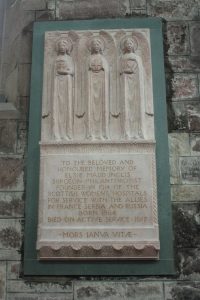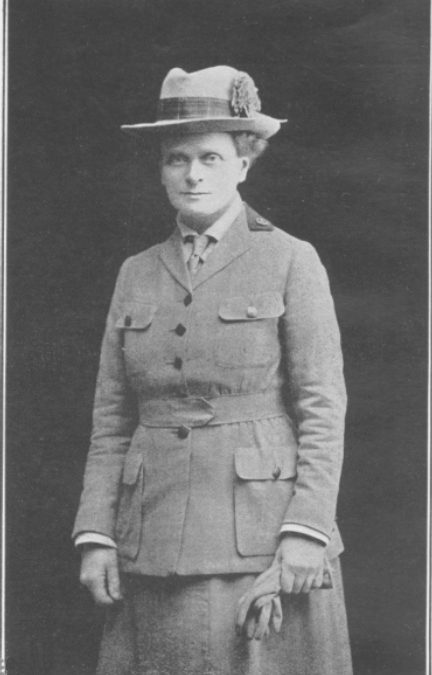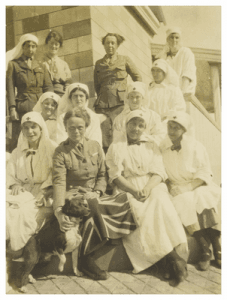As part of International Women’s Day 2022 we take a look at the extraordinary life of Dr Elsie Inglis
Elsie Inglis was born in 1864 in Naini Tal, a hill station located in the foothills of the Himalayas in northwest India. Her family were of Scots descent and her father, John, was employed as the local magistrate. Elsie was one of eight children and, rather unusually for the time, her parents considered the education of their daughters just as important as the education of their sons. Elsie was schooled in India, and later in Hobart, Tasmania, before the family returned to Scotland and settled in Edinburgh.
In 1887 Elsie began studying at the Edinburgh School of Medicine for Women, the innovative and radical (for its time) school founded by Sophia Jex Blake a year earlier. Jex Blake’s uncompromising approach to discipline and her expulsion of two fellow students led Inglis to leave the school, and with the help of her father, she started her own alternative: The Edinburgh College of Medicine for Women. Elsie continued her studies, spending time working in hospitals in Dublin and London, and eventually qualified as a doctor in 1899 (after the University of Edinburgh finally allowed females to graduate!).
Dismayed by the lack of medical provision for women, Elsie set up a maternity hospital entirely staffed by women at 219 High Street (Royal Mile). The hospital was for the poorest women of the Old Town, and Elsie often waived fees and paid for patients to recuperate by the sea. Today you can see a plaque high on the wall at #219 which marks the site of the hospital.
Elsie also became involved with the campaign for women’s right to vote, becoming the secretary of the Edinburgh chapter of the National Society for Women’s Suffrage in 1906 and also of the Scottish Federation of Women’s Suffrage Societies . She campaigned tirelessly and travelled the length and breadth of the UK giving talks and lectures.
With the outbreak of the First World War in 1914, Elsie immediately recognised the urgent need for medical staff on the battlefields of the Western Front. Her idea was to create hospitals and medical units capable of operating on the front line, entirely staffed by female doctors, nurses, orderlies, drivers, and other volunteers. She established the Scottish Women’s Hospitals for Foreign Service (SWH), initially with £100 of her own money and then raised funds through her connections in the suffrage movement. She approached the Scottish Red Cross for help with funding but was rejected, on the grounds that they had “nothing to say to a hospital staffed by women”. She faced similar rejection when she offered the services of SWH to the British War Office, who told her “My good lady, go home and sit still”.
Undeterred, Elsie sent letters to ambassadors of other countries who were more accepting of her idea. The first medical unit of the Scottish Women’s Hospital was sent to France in November 1914. By 1915 the SWH had established an auxiliary hospital at Royaumant Abbey in Val d’Oise, 30km north of Paris. By the end of the war, Royaumont had become the largest continuously operating voluntary hospital in France and had admitted over 11,000 patients, treating casualties from the Battle of the Somme and other major engagements of the campaign on the Western Front.
The Chief: Elsie & some of her nursing sisters, 1916
By Ethel Moir, CC BY-SA 4.0, https://commons.wikimedia.org/w/index.php?curid=61304817Elsie herself travelled initially to Serbia in 1915, then served in Romania and Russia, often under fire and was even taken as a prisoner of war at one point. In southern Russia SWH was engaged to provide medical care to the Serbian Division of the Russian army. The division had no medical facilities of its own, and Elsie led a team of only seven doctors providing care to several thousand men. In recognition of her work with Serbian troops Elsie became known as the “Mother of the Nation” and was awarded the Order of the White Eagle (Serbia’s highest order of merit) in 1916.
However, by 1917 the situation in Russia was becoming increasingly dangerous, with not only the war but the impending Russian revolution. In addition, by the September of that year Elsie was seriously ill with bowel cancer. No longer able to work as a surgeon, she carried on directing the medical unit and refused to leave until the Serbs were evacuated, telegraphing her family to say, “Everything satisfactory and all well except me”. She landed back in Newcastle, England on 25 November 1917 and died the following day. She was fifty-three.
Her body lay in state at St Giles Cathedral and thousands lined the streets of Edinburgh for her funeral, before her burial in the city’s Dean Cemetery. Today a stone tablet dedicated to her memory can be seen in the Holy Cross aisle of St Giles.

Stephencdickson, CC BY-SA 3.0 <https://creativecommons.org/licenses/by-sa/3.0>, via Wikimedia Commons
After Elsie’s death, SWH continued to raise money and to send medical units to the front. Her legacy is extraordinary: during World War One Scottish Women’s Hospitals raised nearly £500,000; established four hospitals and fourteen medical units; sent over 1000 female doctors, nurses, orderlies, and other personnel to the front; operated in France, Serbia, Russia, Romania, Malta, Corsica, and Greece. After the war, the remainder of the funds was used to establish the Elsie Inglis Maternity Hospital in Edinburgh which opened in 1925. Despite public protest, in 1988 services were transferred and the hospital was closed.
Elsie is widely celebrated in Serbia: there is a monument dedicated to her, a hospital named after her and she, along with other female Scottish colleagues, has even featured on Serbian stamps. But despite Elsie’s heroine status in Serbia, her achievements have sadly been often overlooked here in Scotland. Hopefully that is about to change. The Lord Provost of Edinburgh is currently spearheading a campaign to raise funds for a statue of Elsie to be erected on the High Street, close to the site of her original maternity hospital. There are talks and events taking place throughout the city in March 2022. For more information or to donate to the campaign please visit http://www.elsieinglis.org
Related posts
Whoops! No connected account found. Try connecting an account first.



